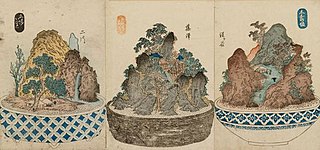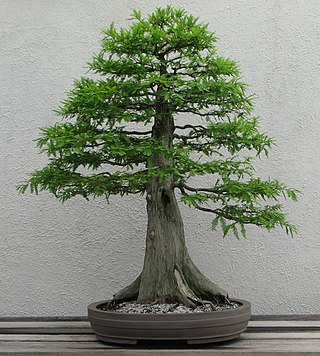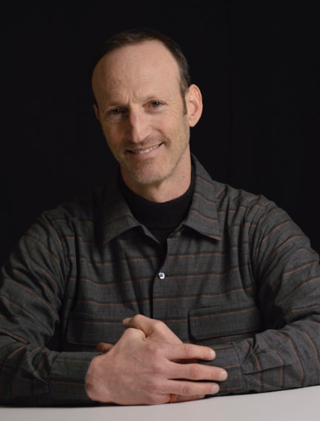Related Research Articles

Bonsai is the Japanese art of growing and shaping miniature trees in containers, with a documented history of influences and native Japanese development over a thousand years long. Similar arts exist in other cultures, including Korea's bunjae, the Chinese art of penjing, and the miniature living landscapes of Vietnamese Hòn non bộ.

Penjing, also known as penzai, is the ancient Chinese art of depicting artistically formed trees, other plants, and landscapes in miniature.

The Portland Art Museum (PAM) is an art museum in downtown Portland, Oregon, United States. The Portland Art Museum has 240,000 square feet, with more than 112,000 square feet of gallery space. The museum’s permanent collection has over 42,000 works of art. PAM features a center for Native American art, a center for Northwest art, a center for modern and contemporary art, permanent exhibitions of Asian art, and an outdoor public sculpture garden. The Northwest Film Center is also a component of Portland Art Museum.

Heathcote Botanical Gardens is a five-acre subtropical botanical garden located at 210 Savannah Road, Fort Pierce, Florida, United States.

A bonkei is a temporary or permanent three-dimensional depiction of a landscape in miniature, portrayed using mainly dry materials like rock, papier-mâché or cement mixtures, and sand in a shallow tray. A bonkei contains no living material, in contrast with related Japanese art forms bonsai and saikei: bonsai contain living trees, and saikei contain living trees and other vegetation.

The Portland Japanese Garden is a traditional Japanese garden occupying 12 acres, located within Washington Park in the West Hills of Portland, Oregon, United States. It is operated as a private non-profit organization, which leased the site from the city in the early 1960s. Stephen D. Bloom has been the chief executive officer of the Portland Japanese Garden since 2005.

Bonsai aesthetics are the aesthetic goals and characteristics of the Japanese tradition of the art of bonsai, the growing of a miniature tree in a container. Many Japanese cultural characteristics, particularly the influence of Zen Buddhism and the expression wabi-sabi inform the bonsai tradition in that culture. A lengthy catalog of conventional tree shapes and styles also helps provide cohesion to the Japanese styling tradition. A number of other cultures around the world have adopted the Japanese approach to bonsai, and while some variations have begun to appear, most hew closely to the rules and design philosophies of the Japanese tradition.

The Larz Anderson Bonsai Collection at the Arnold Arboretum in Jamaica Plain, Massachusetts is one of the premier collections of bonsai in the United States and includes a Hinoki Cypress over 250 years old.

Marco Invernizzi is an Italian bonsai artist and design consultant.

Alan Christopher Chin is a contemporary American artist. He lives and maintains a studio in Hawthorne, California, working in variety of traditional and experimental mediums including, ceramics, film, painting, photography, sculpture, and performance.

The National Bonsai Foundation (NBF) is a nonprofit organization that was created to sustain the National Bonsai and Penjing Museum. NBF also helps the United States National Arboretum showcase the arts of bonsai and penjing to the general public. The National Bonsai and Penjing Museum is located on the 446-acre (1.80 km2) campus of the U.S. National Arboretum in northeast Washington, D.C. Each year over 200,000 people visit the museum. Distinguished national and international guests of various federal departments are also among the visitors.

Masahiko Kimura is a Japanese bonsai artist, born in Ōmiya-ku, Saitama on March 31, 1940.

Richard C. Reames is an American artist, arborsculptor, nurseryman, writer, and public speaker. He lives and works in Williams, Oregon.
Yuji Yoshimura was a second-generation distinguished bonsai master who taught traditional Japanese techniques and aesthetics to enthusiasts in the West.
William N. Valavanis, is a Greek-American bonsai master who carries on Yuji Yoshimura's tradition of teaching Japanese techniques and aesthetics to enthusiasts in the West.

Bonsai is a Japanese art form using trees grown in containers. Similar practices exist in other cultures, including the Chinese tradition of penjing from which the art originated, and the miniature living landscapes of Vietnamese hòn non bộ. The term "bonsai" itself is a Japanese pronunciation of the earlier Chinese term penzai. The word bonsai is often used in English as an umbrella term for all miniature trees in containers or pots. This article focuses on the history of bonsai in Japan and, in modern times, worldwide.
Kunio Kobayashi is a Japanese bonsai artist, and the owner of the Shunkaen Bonsai Museum in Tokyo.

Bjorn Bjorholm is an American professional bonsai artist and educator. He is the founder and owner of Eisei-en Bonsai Garden, which as of early 2024, is in the process of relocating from Mount Juliet, Tennessee, to Kyoto, Japan.

Adam Kuby is an American sculptor, visual artist and landscape designer, focusing on large-scale public art commissions and environmental art installations.

The Luis Vallejo Bonsai Museum is a public access museum located in Alcobendas, Madrid, Spain, dedicated to the display and study of the art of bonsai. The museum was opened in 1995 and is one of the most important in Europe in its class. The museum presents the personal collection of Luis Vallejo as well as specimens donated by others. The collection is widely considered one of the best outside Japan, with multiple trees having received important awards in Spanish and international competitions.
References
- ↑ Snyder, Michael (9 November 2021). "The Ever-Evolving Art of Bonsai". The New York Times. Archived from the original on 2021-11-14. Retrieved 2023-09-12.
{{cite news}}: CS1 maint: bot: original URL status unknown (link) - ↑ "New American Masters – Ryan Neil". bonsaitonight.com. 5 October 2012.
- ↑ "Meet the Man Who Grows Mini Million-Dollar Trees". architecturaldigest.com. 2 May 2017.
- ↑ "Ryan Neil, the Bonsai Master". pen-online.com. 22 November 2018.
- 1 2 "The Bonsai Kid". craftsmanship.net. 15 September 2015.
- 1 2 "Is Portland The Epicenter Of An American Bonsai Movement?". opb. Retrieved 2023-03-20.
- ↑ "How two Glenwood Springs High School grads changed bonsai in the United States". The Denver Post. 2015-10-03. Retrieved 2023-03-20.
- ↑ Robinson, Britany (25 May 2016). "Learning to grow: the American bonsai master who starved for knowledge". The Guardian. theguardian.com.
- ↑ "Meet Ryan Neil". shoutoutcolorado.com.
- ↑ Oregonian/OregonLive, Janet Eastman | The (2016-05-11). "'Unbridled' American bonsai: Portland Japanese Garden's living art exhibit (photos, video)". oregonlive. Retrieved 2023-03-20.
- ↑ "Trees, and Other Entanglements". imdb.com.
- ↑ Moor, Robert (14 November 2022). "The Beautiful, Brutal World of Bonsai". The New Yorker. newyorker.com.